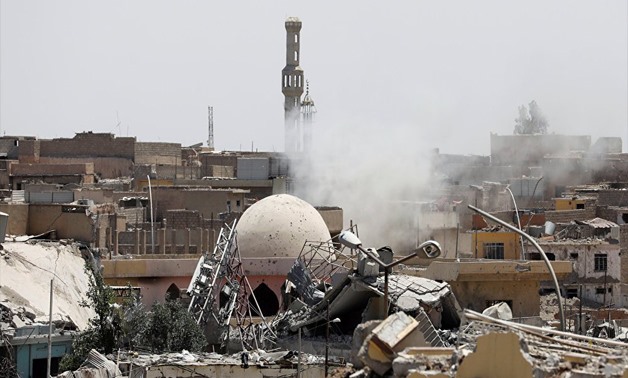
Al-Nuri Mosque after bombing-File Photo
By: CAIRO – 24 June 2017: The Islamic State (IS) terrorist group committed a disastrous historical crime by bombing the landmark great Al-Nuri Mosque and its leaning minaret named al-Hadba ( the hunchback) in western Mosul city in Iraq on June 21.
The Iraqi government announced that the mosque was blown up by Islamic State forces at 9:50 pm. Egypt Today files an overview of the history of this great Mosque.
The Historical value of Al-Nuri Mosque
The Great Mosque of Al-Nuri was built in Mosul, Iraq in the late 12th century, particularly from 1172-1173. It is considered the second Mosque in Mosul after the Umayyad Mosque. Nur Ad-Din Zangi, a Turkish prince who was at the same time the sultan of Syria was the one who gave orders to build Al-Nuri Mosque.
Zangi put Sheikh Umar al-Malla in charge of building the mosque. The properties were acquired at most substantial price. Large sums were expended at the construction, until the mosque was completed in the year 568H.
The mosque is famous for its leaning minaret, known as al-Hadba. The minaret design was inspired from a form originally developed in Iraq and central Asia, similar to other minarets in Northern Iraq. According to old Islamic traditions the minaret gained its tilt after Prophet Muhammed passed while ascending to heaven, part of a physical and spiritual night journey performed by Prophet Muhammad known known as Isra and Mi’raj. Old Christian traditions attributed the mosque tilt to its bowing towards Virgin Mary Tomb.
The Iraqi government undertook a restoration program of Al-Nuri Mosque in 1942, but the minaret remained unrestored. The bombing of Mosul during the Iraq-Iran war in the 1980s resulted in leaks under the minaret, causing the lean to increase by 40 centimeters.
The building remained steadfast for nearly 850 years, and survived the Mongol invasion, but unfortunately it couldn’t survive Islamic State bombing. German archaeologist Ernest Herzfeld performed a study on the mosque in the early 20th century, later the condition of the mosque deteriorated. It is worth mentioning that Al-Nuri Mosque was symbolically important to Islamic State and their leader Abu Bakr al-Baghdadi as it was used in 2014 to declare their Caliphate, where Al-Baghdadi gave speech in the Mosque in July 2014 directly after the Mosul battle.
Comments
Leave a Comment